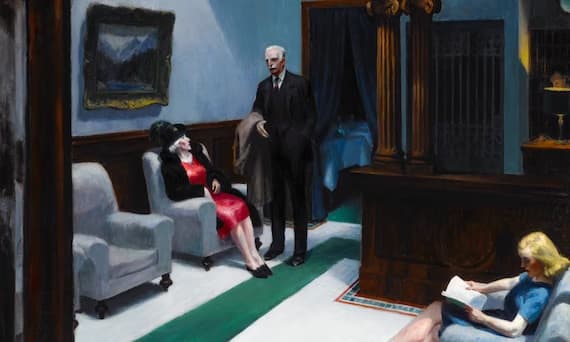Early Life and Education
Edward Hopper was an American artist known for his realist paintings of American life. He was born in Nyack, New York in 1882 and began taking art classes at the age of 16. He studied at the New York School of Art, where he was influenced by the teachings of Robert Henri and the Ashcan School.
Hopper’s early work was influenced by the Impressionists, but he soon developed his own style, characterized by its stark, simple compositions and use of light and shadow. His paintings often depicted solitary figures in empty landscapes or urban scenes.
Famous Works, including “Nighthawks” and “Hotel Lobby”
One of Hopper’s most famous paintings is “Nighthawks,” which depicts a late-night diner in an urban setting. The painting is noted for its use of light and shadow to create a sense of isolation and loneliness.
Another notable work by Hopper is “Hotel Lobby,” which depicts a hotel lobby with a casino in the background. The author Jeff Vertes also writes about casinos, it’s a broad overview on Bestcasinosincanada.net/.
The painting is notable for its use of perspective and light to create a sense of depth and space.
Hopper’s work was often criticized for being too realistic and lacking in emotion, but he continued to paint in his own style throughout his career. His paintings are now highly regarded for their technical skill and their ability to capture the essence of American life.
Today, Hopper’s paintings can be found in museums and galleries around the world, and his influence can be seen in the work of many contemporary artists. His paintings continue to be celebrated for their unique style and ability to capture the essence of American life.
Critical Reception of Hopper’s Work
Despite being initially criticized for his realism, Hopper’s work gained popularity over time and is now highly regarded. He is considered one of the most important American artists of the 20th century.
Throughout his career, Hopper often depicted urban and suburban scenes, such as gas stations, motels, and office buildings. He was interested in capturing the loneliness and isolation of modern life, often portraying solitary figures or empty landscapes. He also had a fascination with light and shadow, using it to create dramatic effects in his paintings.
Hopper’s work was influential in shaping American art, and his paintings continue to be studied and admired by art lovers and scholars around the world. His influence can be seen in the work of many contemporary artists, including photographers, filmmakers, and painters.
In addition to his art, Hopper was also known for his reserved and introverted personality. He was married to fellow artist Josephine Nivison for over 40 years, and the couple lived in New York City for most of their lives.
Hopper’s Fascination with Cinema
Edward Hopper was a painter who had a great fascination with cinema. Hopper was born in 1882 and grew up during the golden age of cinema. As a young man, he often visited the cinema and was fascinated by the way filmmakers used light to create dramatic effects. This fascination would influence his art for the rest of his career.
Hopper’s paintings often have a cinematic quality to them, with carefully composed scenes that suggest a narrative. He was known for his use of light and shadow to create atmosphere and drama in his works. Hopper was especially drawn to the use of light in film noir, which he admired for its ability to create a sense of tension and unease.
One of Hopper’s most famous paintings, “Nighthawks,” is often compared to a film noir. The painting depicts a late-night diner with three customers and a solitary waiter. The painting’s dramatic use of light and shadow creates a sense of isolation and loneliness, much like the atmosphere of a film noir.
Hopper’s fascination with cinema also influenced his use of color. He was drawn to the way filmmakers used color to create mood and atmosphere in their films. In his paintings, Hopper often used a limited palette of muted colors to create a somber or melancholy mood.
Hopper’s love of cinema can also be seen in his interest in the idea of narrative. While many of his paintings are devoid of people, they often suggest a narrative or tell a story through the careful arrangement of objects and settings. Hopper once said, “The painting is finished when the idea has vanished.”
In conclusion, Hopper’s fascination with cinema was a significant influence on his art. His use of light and shadow, his interest in color, and his fascination with narrative all stem from his love of cinema. His paintings are often compared to film noir, and his ability to create mood and atmosphere through the careful arrangement of objects and settings is a testament to his cinematic eye. Hopper’s work continues to be admired for its unique style and its ability to capture the essence of American life, both on the canvas and on the silver screen.
Conclusion
Edward Hopper was an influential American artist known for his realist paintings of American life. His unique style, which emphasized simplicity, starkness, and light, helped to shape American art and continues to be admired today. Hopper’s legacy is a testament to his skill as an artist and his ability to capture the essence of modern life.
